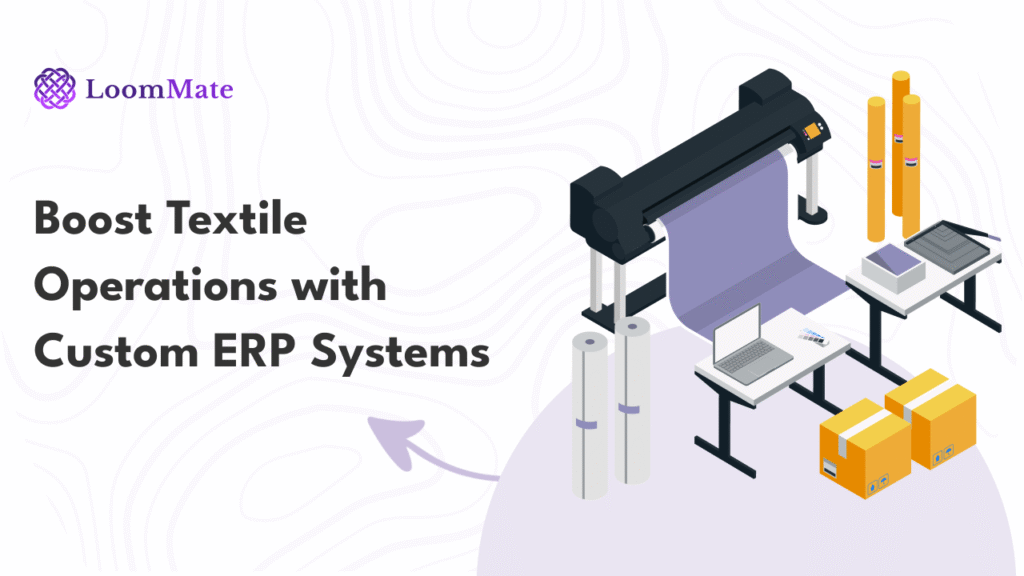Introduction
The textile industry requires many complicated processes, including material procurement, production leaders, inventory management, and sales order processing. Textile businesses need a centralized system that connects all divisions so as to oversee all of these procedures efficiently. ERP software becomes essential in this scenario.
Textile businesses may handle their daily activities from one location with the aid of ERP software. It combines several operations into a single platform, covering sales, production, inventory, and finance. Businesses may boost efficiency, reduce errors, and improve collaboration among departments with the right ERP solution.
This article will go over 10 specific ways that ERP software, especially cloud-based ERP software, could assist the textile industry. This article will discuss why ERP is necessary for modern textile companies rather than just a choice.
How ERP Software Works
ERP software works by integrating every business function into a single system. It allows immediate information sharing among departments. For example, the inventory team is instantly notified when the marketing team provides a new order. The purchasing team may place a fresh purchase right away if inventory levels decrease.
A textile ERP software program links many procedures, including
- Inventory management
- Production planning
- Procurement
- Quality control
- Finance and accounting
- Sales and distribution
- Customer relationship management (CRM)
When businesses use cloud-based ERP software, all of these features can be managed at any location with internet access. Businesses who operate in numerous sites or wish to maintain an eye upon activity in actual time will find this helpful.
10 Benefits of ERP Software for the Textile Industry
1. Improved Inventory Management
In the textile sector, inventory control is one of the most difficult problems. Organizations may have shortages or excessive stock if adequate surveillance isn’t done. Real-time inventory tracking is aided by ERP software. It shows the levels of raw materials, production stock, and available stock.
This helps managers avoid waste and make purchases more easily. Also, it reduces delays in production caused on by lost materials.
2. Streamlined Production Planning
Textile production requires careful planning across multiple steps, including spinning, weaving, dyeing, sewing, and finishing. By combining personnel, equipment capacity, and raw material availability, textile ERP software helps with production scheduling.
Problems are avoided if the entire process is more visible. Managers are able to keep an eye on delay and react quickly to address them.
3. Real-time Reporting and Analytics
The immediate reporting function in modern cloud-based ERP software is one of its biggest advantages. The dashboards and reports enable owners and managers to monitor achievement in every area.
This enables data-driven decision-making. For example, the team may move fast to determine the reason and coming up with an answer if sales are declining in a particular region.
4. Better Financial Management
For any textile company, handling finances is essential. Reporting on finances, accounts payable, accounts receivable, billing, and invoicing may all be handled with ERP software.
Errors and manual entry are reduced with textile ERP software. In addition, it helps with filing taxes, GST compliance, and audit preparation. Everything is stored in a system which keeps it safe and readily available.
5. Efficient Order and Sales Management
Sales are tracked from inquiry to delivery through an ERP system. The software updates the shipment schedule and checks inventory and production schedules when a customer places an order.
Each order’s status can be viewed by sales teams. Consumers feel more satisfied as a consequence of businesses having the ability provide exact delivery dates.
Read More: Manage Your Textile Finances Easily with LoomMate
6. Quality Control Tracking
The production of textiles depends heavily on quality. ERP software includes quality checks for raw materials, in-process, and final products.
Issues can be noted and tracked. This reduces rejection or rework rates and improves product standards.
7. Improved Communication Between Departments
A textile company’s different divisions must collaborate well. The sales staff, for example, needs to interact with the production and inventory departments.
This data sharing has been rendered feasible by ERP software. Because everybody utilizes the same system, this is fewer confusion and better teamwork.
8. Vendor and Purchase Management
Textile businesses depend on providers for their raw materials. An ERP system for textiles maintains track all of the suppliers, past purchases, delivery dates, and costs.
It enables better deal negotiations and vendor performance comparisons. For the purpose of to avoid overstocking or understocking, purchases can be planned accordingly to actual demand.
9. Multi-location and Multi-unit Support
Numerous textile enterprises operate throughout states or localities. Multiple locations can be handled from a single platform using cloud-based ERP software.
Companies with distinct equipment for moving, dying, and garments will find this helpful. Each unit can be controlled by administrators using one platform.
10. Improved Customer Relationship Management (CRM)
A CRM element is frequently included with textile ERP software. This simplifies the administration of follow-ups, order pasts, and interactions with clients.
In addition, it assists marketing and salespeople keep updated and provide superior service to clients. Recurring revenue is more inclined to originate from happy customers.
How LoomMate Helps Textile Businesses
A specialized textile ERP software designed to meet the specific needs of the textile sector is called LoomMate. All of the essential functions are provided in one user-friendly platform, including finance, sales, production, and inventory.
LoomMate also provides online ERP software, that allows business owners to obtain data and oversee activities even when they are not in their workplace. LoomMate helps textile enterprises in being more effective and organized with features such as production management, order tracking, and GST billing.
Conclusion
In today’s competitive textile market, utilizing spreadsheets and manual processes is inadequate. From production and inventory management to sales and finance, an ERP program provides an integrated solution.
Textile ERP software helps groups work more efficiently, reduce waste, and provide superior service to clients with abilities like real-time tracking, technology, and access to the cloud. ERP systems like LoomMate could enhance the effectiveness and structure of your textile company, no matter what size it is.
A long-term move toward stability, growth, and profitability in the textile sector involves a purchase in an appropriate ERP system.
FAQs
Q1. What is ERP software in the textile industry?
An ERP system will help textile companies that want to manage their processes under one umbrella; inventory, sales, production, and finance are some of these processes.
Q2. Why is cloud-based ERP software useful for textile businesses?
In-cloud ERP can be used to access business data from any location, which proves useful when business activities at multiple locations must be monitored, and decisions need to be made in real-time.
Q3. Can ERP software handle textile production processes?
Yes, indeed. Textile ERP systems have the capability to undertake production planning, scheduling, raw-materials tracking, and quality control processes.
Q4. Does ERP software help with finance and tax compliance?
It sure does; ERP is equipped with modules for billing, accounting, GST returns, and tax reporting that can save much manual effort.
Q5. How does ERP improve efficiency in textile operations?
By providing integration among various departments, ERP eliminates delays, errors, duplication of work, and, consequently, leads to a more efficient way of doing the work.



